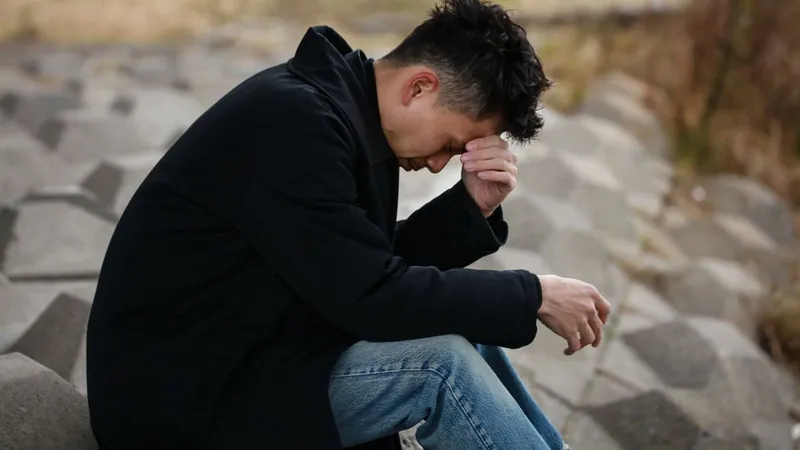
Alarming Study Reveals Higher Suicide Risks on New Year’s Day and Mondays Worldwide
2024-10-23
Author: Siti
Introduction
A groundbreaking global study has unveiled a troubling trend: people are significantly more likely to die by suicide on Mondays compared to any other day of the week, with a similar spike occurring on New Year’s Day. This comprehensive analysis examined 1.7 million suicide cases across 26 nations from 1971 to 2019, shedding light on this critical public health issue.
Global Insight on Suicide Rates
The research, published in the esteemed medical journal BMJ, highlighted that while suicide rates peaked on Mondays across various countries, marked regional variations were also evident. For instance, North America, Asia, and Europe generally experience lower suicide rates during weekends, while countries in South and Central America, Finland, and South Africa saw an uptick in weekend suicides—a stark contrast that calls for further exploration into local cultural and societal influences.
Examined Countries and Hypotheses
Countries included in this analysis span across Europe, such as the Czech Republic, Estonia, Germany, and the United Kingdom. However, the reasons behind this phenomenon remain unclear. Experts suggest that factors like heightened work pressure at the start of the week, increased alcohol consumption over the weekend, and social isolation during the holiday season—especially affecting men—could significantly contribute to these patterns.
Insights from Experts on New Year’s Day Risks
Notably, the heightened suicide risk on New Year’s Day might be linked to the anxiety and fear that often accompany hangovers, according to Brian O’Shea, an assistant professor of social psychology at the University of Nottingham. 'Individuals tend to drink far more than usual, and when compounded with existing emotional stress and alcohol withdrawal, this can lead to devastating outcomes,' O’Shea revealed.
Holiday Season Risks: A Deep Dive
The study also explored suicide trends during other holidays. On Christmas Day, the patterns varied significantly; in many Central and South American nations and South Africa, suicides typically rose, whereas North America and Europe reported declines. The risk associated with New Year’s Day varied by region—its impact being negligible in Japan but most pronounced in Chile.
When examining the effects of the Lunar New Year in countries like China, South Korea, and Taiwan, the researchers found a notable reduction in suicide risk only for South Korea. Conversely, overall suicide rates tended to dip slightly on national holidays, though increases were sometimes observed shortly thereafter.
The authors posited that stronger family and social ties could be protective factors against suicide during holidays, emphasizing the need for additional studies due to the diverse suicide rates across different countries.
Understanding Underlying Factors
Various factors, such as the influence of alcohol, social isolation, and work-related stress, can possess differing impacts depending on cultural norms, religious beliefs, holiday schedules, and work-life balance expectations in different regions. Martin Plöderl, a clinical psychologist at Paracelsus Medical University in Austria, highlighted the importance of examining these socio-cultural dynamics.
Plöderl noted that similar trends have been observed in Austria, where suicide rates peak post-major holidays, notably after New Year’s Day. While the study does provide a global perspective, transformable insights can be drawn to enhance understanding of the increased suicide risk during these periods. This knowledge could be vital in informing mental health professionals, enabling them to better tailor their services around critical times.
Call to Action for Suicide Prevention
The study underscores a pressing need for heightened awareness during these vulnerable periods—particularly on New Year’s Day, which is currently overshadowed by the focus on Christmas. O’Shea advocates for increased staffing and resource allocation for suicide prevention hotlines during high-risk times, emphasizing the necessity for proactive measures to lower suicide rates.
'This insight at an epidemiological level means we can allocate resources effectively and ensure there are sufficient trained personnel available to provide support when it’s most needed,' he said. The implication is clear: with targeted intervention, we have the potential to save lives during these critical periods identified in the study.





 Brasil (PT)
Brasil (PT)
 Canada (EN)
Canada (EN)
 Chile (ES)
Chile (ES)
 España (ES)
España (ES)
 France (FR)
France (FR)
 Hong Kong (EN)
Hong Kong (EN)
 Italia (IT)
Italia (IT)
 日本 (JA)
日本 (JA)
 Magyarország (HU)
Magyarország (HU)
 Norge (NO)
Norge (NO)
 Polska (PL)
Polska (PL)
 Schweiz (DE)
Schweiz (DE)
 Singapore (EN)
Singapore (EN)
 Sverige (SV)
Sverige (SV)
 Suomi (FI)
Suomi (FI)
 Türkiye (TR)
Türkiye (TR)